The rainy
season with high temperature and humidity in Japan starts in June.
And bacteriae can easily propagate in this environment and foods
themselves become tainted, too. Then, bacterial enteritis (food
poisoning) often breaks out. The infected enteritis breaks out
in winter, too, but the main cause of the enteritis is ROTA virus,
SRV (Small Round shape Virus) and CORONA virus etc. This page
shows the cause of the bacterial enteritis (food poisoning), the
features by each bacteria, diagnosis, therapy and how to prevent
food poisoning.
1.The classification
of major food poisoning
2.Major
bacteriae of the infectious food poisoning
3.Diagnosis of food poisoning
4.Treatment of food poisoning
5.Prevention of bacterial food poisoning
1.The classification of food poisoning
There
are a few sorts of food poisoning. They are the enteritis due
to the chemical agents such as alcohol, and due to the
poisonous matter in the nature such as globefish poison
and poisonous mushrooms etc. And others are the infectious
gastroenteritis by virus and bacteriae etc. Further, bacterial
enteritis occurs by bacteriae themselves and by toxin from bacteriae.
Food poisoning due to the chemical agents and the poisonous matter
in the nature account for less than 2% of whole food poisoning
(by cause), but they occupy 6-8% of total number of food poisoning
cases, and the death rate in cases by poisonous mushrooms and
globefish poison is higher than other bacterial food poisoning.
The cause of more than 90% of food poisoning is bacteriae, and
they are salmonella, staphylococcus, Vibrio
parahaemolyticus, enteropathogenic Escherichia coli
(haemorrhagic Escherichia coli; O-157 etc), Campylobacter,
Welch bacillus, Bacillus cereus, Botulinus bacillus,
Dysentery bacillus, Cholera vibrio, Listeria
monocytogenes etc, and the bacteriae printed in italics are
increasing recently. Food poisoning by Listeria monocytogenes
are often seen in Europe and America by cheese, and Vibrio
vulnificus infection to a person with hepatic disturbance
may bring the serious disorder, and this bacteria is called "the
man-eater bacteria".
Top
of this page
2.Bacteriae of food poisoning (bacterial enteritis)
(1)Salmonella(microscope image)
 The anaerobic Gram positive bacillus
of 0.5-2μm, and it has flagellum around body and moves actively
in the intestine. More than one million bacteriae can bring disorder.
This bacteria is seen lot in the nature (river, pond and drains
etc) and it has no spore so it will die by heating easily. Especially
eggs and chicken meat will often be tainted by this bacteria.
The anaerobic Gram positive bacillus
of 0.5-2μm, and it has flagellum around body and moves actively
in the intestine. More than one million bacteriae can bring disorder.
This bacteria is seen lot in the nature (river, pond and drains
etc) and it has no spore so it will die by heating easily. Especially
eggs and chicken meat will often be tainted by this bacteria.
(2)Vibrio parahaemolyticus(microscope
image)
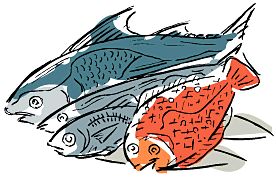 Gram
negative bacillus with one flagellum and some thin cilii. It has
no spore as salmonella so it will die by heating easily, too.
It propagates in sea water (3% of salt content), and it cannot
live in water without salt content or in acids. Seafoods are often
tainted, and it propagates in room temperature, so the preservation
of seafoods needs much care in this rainy season.
Gram
negative bacillus with one flagellum and some thin cilii. It has
no spore as salmonella so it will die by heating easily, too.
It propagates in sea water (3% of salt content), and it cannot
live in water without salt content or in acids. Seafoods are often
tainted, and it propagates in room temperature, so the preservation
of seafoods needs much care in this rainy season.
(3)Staphylococcus(microscope
image)
Staphylococcus is a major pyogenic bacteria of1μm size and it swarms like a grape
bunch. They can be found usually on skin or hair (fur), in nasal
cavity and larynx etc. It produces enterotoxin and 100 degrees
centigrade heating cannot activatethe the enterotoxin. So it is
important not to make foods be contaminated.
(4)Haemorrhagic Escherichia coli(O-157)・Enteropathogenic
E.coli(microscope image)
These bacteriae are Gram negative bacilli living in
the intestines of animals, and ther is no definite difference
except pathogenesis between these bacteriae and other indigenous bacterial flora of colibacillus. Drinking
water may be contaminated by excrement and urine, or raw meat
may be contaminated through dealing process. It has no spore so
it will die by heating but very little volume (only 100 bacilli!)
can make a person become ill. O-157, O-26, O-111 and O-128 are
known and they produce verotoxin and it can be a cause of HUS
(Hemolytic Uremia Syndrome) which may bring death to a patient.
(5)Campylobacter(microscope
image)
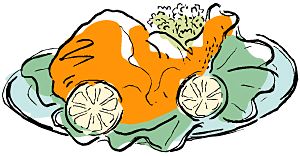 This is a Gram negative bacillus
with cord-like flagella at both ends and usually live in the intestine
of domestic animals and domestic fowls. Meat especially chicken,
viscera and drinking water are often tainted. And it is important
as a cause of children's diarrhea. It is very weak to heating
and dryness.
This is a Gram negative bacillus
with cord-like flagella at both ends and usually live in the intestine
of domestic animals and domestic fowls. Meat especially chicken,
viscera and drinking water are often tainted. And it is important
as a cause of children's diarrhea. It is very weak to heating
and dryness.
(6)Botulinus
bacillus(microscope
image)
Gram positive anaerobic bacillus living in the nature
such as soils and in the intestine of domestic animals. It has
a spore and is resistant to heat. Botulinus toxin which has very
strong toxicity to nerve system, and it needs 80 degrees centigrade
heating for more than 20 minutes to inactivate this toxin. Food
poisoning by botulinus is important because its death rate is
high (25%).
(7)Welch
bacillus(microscope
image)
Gram positive anaerobic bacillus usually seen in the
intestines of human and animals, soils and sewages. It forms a
spore and produces toxin according to increasement. More than
1 million bacilli can bring disorder to human body, and it is
known as a cause of gas gangrene at wartime. Heating by 100 degrees
centigrade for 1 - 2 hours is necessary to inactivate it.
(8)Bacillus cereus(microscope
image)
Gram positive aerobic bacillus widely seen in the
nature such as soils, sewages and rivers. It exists as a spore
form which is resistant to heat, and it produces toxin. Heat tolerance
is strong and heating by 100 degrees centigrade for 30 minutes
cannot kill this spore, but it can be a cause of mild food poisoning
as diarrhea type and vomiting type.
(9)Cholera vibrio
Gram negative bacillus which belongs to the vibrio
group. It has one flagella at one side and makes no spore. It
will die soon in gastric juice, but when it reaches to the intestine,
it produces cholera toxin and brings diarrhea. Cholera vibrio
O-1 and O-139 infection are specified to the infectious disease
designated by law, and non-O-01 and non-O-139 are related with
food poisoning.
(10)Dysentery bacillus
Gram negative bacillus which shows pathogenesis to
only humans and apes (Primates). It invades and destroys epithelium
cells of the intestine and becomes a cause of bloody stool, so
infection by this bacteria is regarded as the infectious disease
designated by law.
(11)Pfeiffer
bacillus (Yersinia)
It
is widely seen in the nature and in the intestine of the animals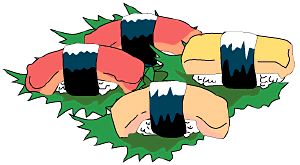 , and edible meat and drinking water may be
tainted by contaminated excreta. It can propagate in the low temperature
of a refrigerator, so you should not be careless.
, and edible meat and drinking water may be
tainted by contaminated excreta. It can propagate in the low temperature
of a refrigerator, so you should not be careless.
(12)Listeria monocytogenes
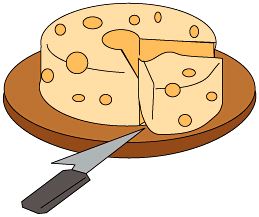 It is
widely recognized in animals (both domestic animals and wild animals),
fishes and in rivers. Edible meats, cheese (non-sterilized), salad,
sashimi (raw fish) etc are often tainted. It is important in Europe
because they deal much cheese. It can propagate in low temperature
in a refrigerator but heating by 65 degrees centigrade for a few
minutes can kill this bacteria.
It is
widely recognized in animals (both domestic animals and wild animals),
fishes and in rivers. Edible meats, cheese (non-sterilized), salad,
sashimi (raw fish) etc are often tainted. It is important in Europe
because they deal much cheese. It can propagate in low temperature
in a refrigerator but heating by 65 degrees centigrade for a few
minutes can kill this bacteria.
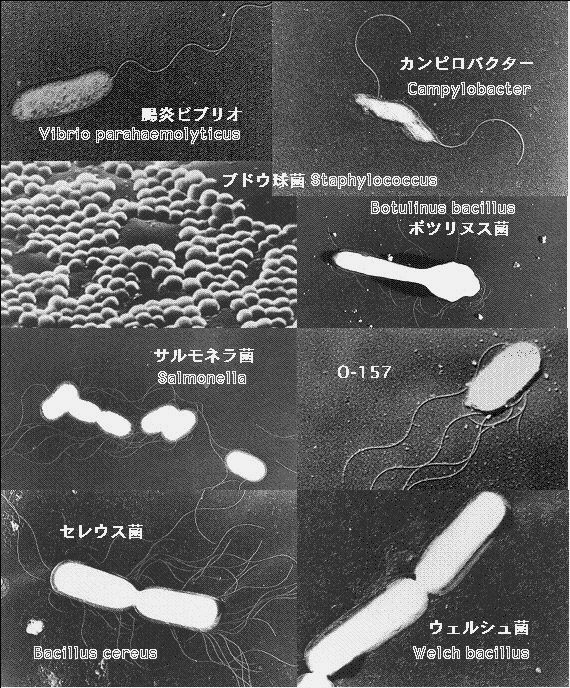
TOP
of this page
3.Diagnosis of food poisoning
The
cause of bacterial enteritis is various bacteriae, so its diagnosis
is done by detection of bacteriae in blood or stool and detection
of toxin are diagnostic method. Practically, however, it take
time to get the definite diagnosis by these examinations, and
it is hard for a patient who is suffering from diarrhea, nausea,
vomiting, fever and abdominal pain etc on coming. Therefore, blood
and stool examination should be done and we should make diagnosis
by the patient's symptoms, family history whether the patient's
family complain of the same symptoms as the patient, history of
eating and drinking, and history whether the patient has been
abroad or not. And treatment should be started as soon as possible.
The following table shows the feature of each bacterial enteritis;
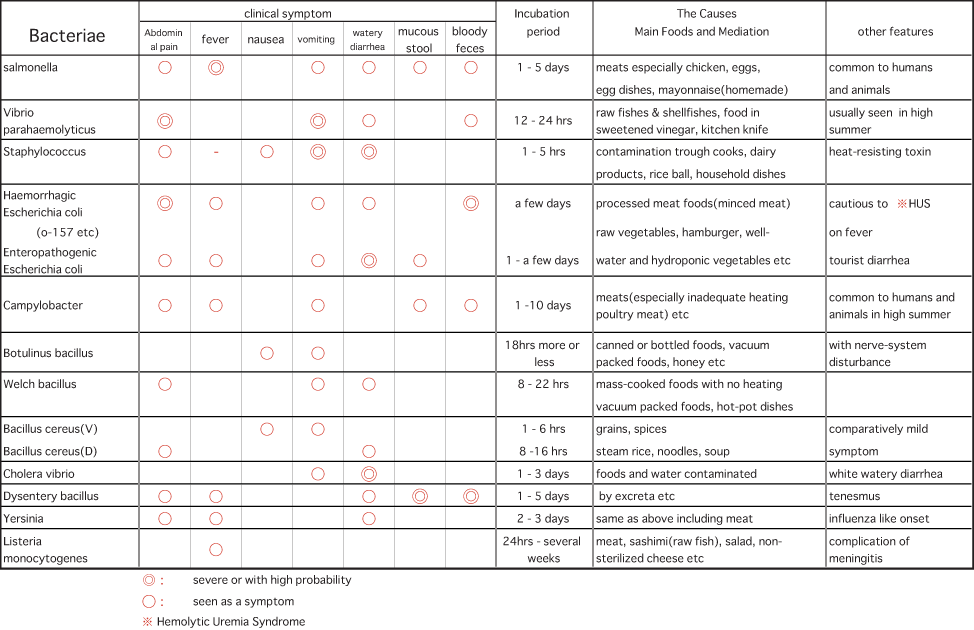
TOP
of this page
4.Treatment of Food Poisoning
Following therapeutic methods are
common.
A.antiemetic drugs
When
a patient is suffering from severe nausea and vomiting, antiemetic
drugs may be used, but its dose should be minimum amount.
B.analgesics
When a patient
is suffering from abdominal pain, analgesics can be used but its
dose should be minimum amount, too.
C.antidiarrhoics
Even in a case with severe diarrhea, antidiarrhoics
should not be used because the use of this kind of drugs will
make bacteriae be excreted and so recovery from disease may be
delayed. Therefore the patient should understand the reason why
antidiarrhoics should not be used in bacterial enteritis.
D.dietetic therapy
Putting
a patient on a dietetic therapy is not always necessary except
a case with severe symptoms. In a mild case, a patient may take
digestible food little by little. Restriction to take water should
not be done in order to prevent dehydration.
E.water
(control of dehaydration)
In a case which
restriction water as oral ingestion is necessary, urine volume
should be kept by drip-infusion (fluid therapy). In a mild case,
taking of the sports drinks which contain electrolytes. But please
notice that the sports drink does not always contain salt enough.
F.antibiotics
Antibiotics is
not always used to cases of bacterial enteritis, but antibiotics
may be administered to some cases of salmonella infection (newquinolone,
ampicillin and fosfomycin etc), some cases of Campylobacter
infection (macrolides) and some cases of Enteropathogenic Escherichia
coli infection (newquinolone
and fosfomycin etc) with serious symptoms.
G.therapy
to the botulinus toxin
The respiratory care
by airway management should be done because nerve toxin will exacerbate
the respiratory function. And polyvalent antitoxin serum must
be administered at once.
TOP
of this page
5.Prevention of Food Poisoning (bacterial enteritis)
About the prevention of food poisoning, knowledge
about eachbacteria and infection route etc is important. About
the infectious route, it can be devided into the primary infection
and the secondary infection. Then it will be easy to understand.
(1)Prevention of the primary infection
1.Foods
enough washing、full thawing-out
the frozen meat、sufficient heating
2.Sanitary control
of kitchen, dresser and cooking instruments
keep
clean the chopping board, kitchen knife and cooking instruments
by boiling water and disinfectant soap or sodium hypochlorite
is effective.
3.Sanitary control of cooks and staff
Keep hands clean by washing or taking gloves is effective.
4.Sanitary control of cooked foods
It
makes cooked foods be bad to leave them long. Do not overestimate
cooked foods in your refrigerator please.
(2)Prevention
of the secondary infection
The bacteriae that
may be the cause of the secondary infection (the bacteriae from
the infected person will bring the same infection to others.)
are dysentery, cholera and enterohaemorrhagic Escherichia coli.
A case of botulinus infection sometimes becomes serious but there
is no report about secondary infection case.
1.Washing
hands・Strict enforcement of disinfection・Taking gloves
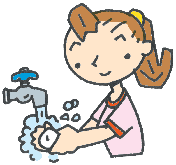 The bacteriae mentioned
above spread through stools etc, so washing hands by enough flowing
water and sodium hypochlorite or disinfectant soap. Of course
washed hands must be dry and be kept clean. Medical staff should
take glove when they contact patienets with food poisoning, and
of course washing hands is indispensable. WHO reported the effectiveness
of washing hands and taking gloves in cases of SARS.
The bacteriae mentioned
above spread through stools etc, so washing hands by enough flowing
water and sodium hypochlorite or disinfectant soap. Of course
washed hands must be dry and be kept clean. Medical staff should
take glove when they contact patienets with food poisoning, and
of course washing hands is indispensable. WHO reported the effectiveness
of washing hands and taking gloves in cases of SARS.
2.Laundry of linen, bedclothes and clothes
Linen,
bedclothes and clothes with excrement from a patient with bacterial
enteritis (including secondary infection) should be washed with
detergent and by hot water of 80 degrees centigrade for 10 minutes.
In a case that hot water cannot be used, these clothes etc should
be soaked in the sodium hypochlorite (0.01 - 0.1%) for more than
5 minutes at rinse.
3.Sanitary control of a washstand
at a lavatory etc.
A lavatory and a place around
the washstand are humid, and bacteriae will easily propagate in
these area with suitable temperature. So it is necessary to keep
these area dry and clean by soap and the sodium hypochlorite.
Japanese MInistry of Health, Labour and Welfare shows the six
points to prevent food poisoning for the household (1977), and
please check it if you are interested.
TOP
of this page
TOP of the
information page



 The bacteriae mentioned
above spread through stools etc, so washing hands by enough flowing
water and sodium hypochlorite or disinfectant soap. Of course
washed hands must be dry and be kept clean. Medical staff should
take glove when they contact patienets with food poisoning, and
of course washing hands is indispensable. WHO reported the effectiveness
of washing hands and taking gloves in cases of SARS.
The bacteriae mentioned
above spread through stools etc, so washing hands by enough flowing
water and sodium hypochlorite or disinfectant soap. Of course
washed hands must be dry and be kept clean. Medical staff should
take glove when they contact patienets with food poisoning, and
of course washing hands is indispensable. WHO reported the effectiveness
of washing hands and taking gloves in cases of SARS.